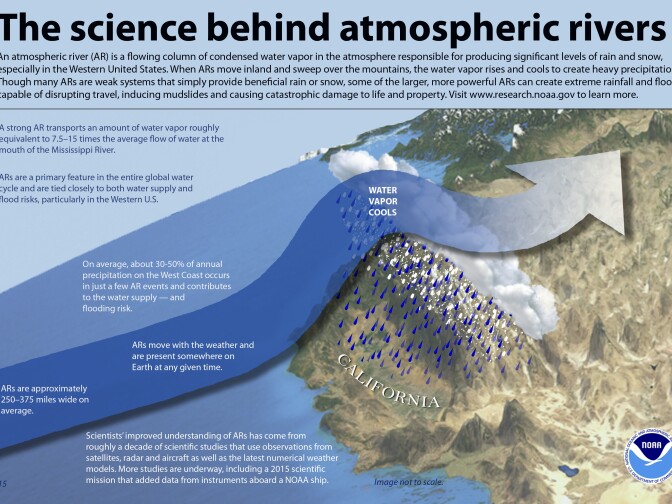Truth matters. Community matters. Your support makes both possible. LAist is one of the few places where news remains independent and free from political and corporate influence. Stand up for truth and for LAist. Make your year-end tax-deductible gift now.
This archival content was originally written for and published on KPCC.org. Keep in mind that links and images may no longer work — and references may be outdated.
Why atmospheric rivers can be a blessing and a curse
Southern Californians are bracing themselves for the heaviest part of what's expected to be the strongest storm of the year. Five to 10 inches of rain could hit the burn areas of Santa Barbara and Ventura counties, prompting mandatory evacuation notices to be issued by local authorities, as mudslides have become a concern.
The gigantic amount of water barreling towards the area is called an atmospheric river. A storm system that begins far out at sea and gathers abundant moisture as it travels towards land, often driven by high winds. Atmospheric rivers can be bigger than 300 miles across, hold more than 10 times the amount of water found in the Mississippi River, and they can be both a boon and a threat to the state.
A boon, because we only see a handful of them each year, yet they're responsible for 50 percent of the annual precipitation California receives.

But they can be a threat because they are capable of releasing enough water at one time to cause dangerous debris flows, which is exactly what happened when an atmospheric river hit the freshly burned Montecito area back in January. More than half an inch of rain fell in five minutes, and at least 21 people were killed.
"They benefit our water supply, but if they come with too much intensity or on top of the previous storm that’s already made the ground real wet, they can also create major hazards," said Marty Ralph, director at the Center for Western Weather and Water Extremes at UC San Diego, who studies the storm systems.
This latest downpour is likely welcomed in parts of Santa Barbara, Ventura and Los Angeles counties, which are experiencing extreme drought conditions, even after California's wet winter last year.
However, the threat of mudslides is back. According to U.S. Geological Survey hydrologist Jason Keane, half an inch of rain over the course of an hour is all it takes to trigger debris flows in mountains scorched by fire. Forecasters with the National Weather Service say this storm could drop half an inch to an inch of rain, per hour, in some spots.
A loss of vegetation and alteration of soil characteristics following the largest wildfire in state history, means that the land is less able to absorb water and stay in place. Coupled with the fact that the mountains in the area are particularly steep, mudslides are more likely.
For weather events that can have such a huge impact on the state, the storm systems are near impossible to predict. When trying to determine where an atmospheric river might touch down, even three days out, the margin of error is about 190 miles, according to Ralph. That's roughly the distance between San Luis Obispo and Los Angeles. This year, Ralph and others have been studying the storm systems with the hopes of being able to better understand them.
This winter, Ralph boarded multiple planes and flew out over atmospheric rivers off the coast of California. While in the air, the crew released dropsondes, or instruments that can measure temperature, wind, humidity and pressure, in the river itself. With the data, Ralph said that they hope to better understand the weather systems and improve their prediction models.










